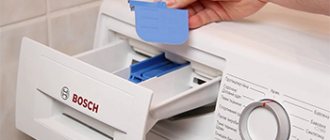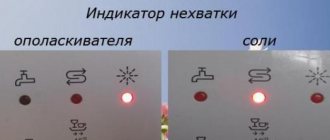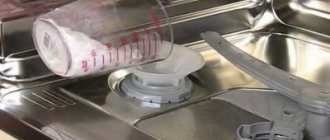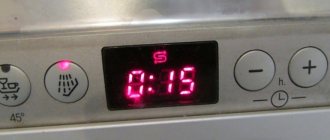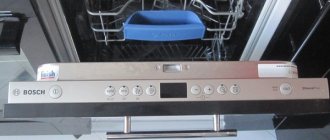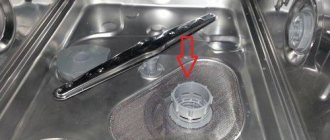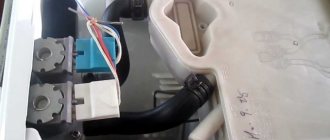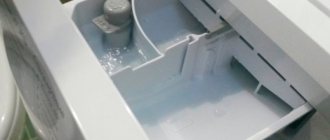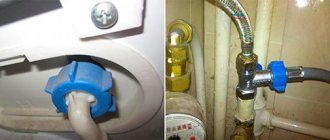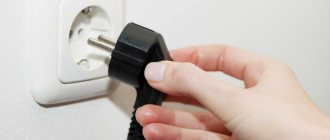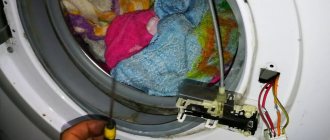A dishwasher of any brand, even a branded one, can present an unpleasant surprise in the form of excessive foaming. So why is there foam left at the bottom of the dishwasher ? Let's consider the main causes of this phenomenon and ways to eliminate them.
Why does my dishwasher leave foam at the bottom?
Normally, the dishwasher should remain clean after finishing the cycle, but many people experience increased foaming. Usually the problem does not indicate the presence of serious damage, but only indicates incorrect operation of the device.
Surface blockage
A common cause of foam formation is a small blockage that has formed on the mesh of the garbage filter. If you constantly load plates with residues of dense fat into the machine, sooner or later it will clog the microscopic holes at the bottom of the device’s chamber. The water will drain worse, and accordingly, the remaining detergent will begin to linger in the hopper even after the end of the work cycle.
Foam remains in the dishwasher for two reasons - either there is more of it than necessary, or it cannot drain normally.
Incorrect settings
A standard dishwasher works with both cleaning powders and cleaning tablets. Since the structure of detergents is different, they dissolve in water differently, for each type it is necessary to set separate settings.
If foam remains in a dishwasher without powder, this means that the detergent is not dissolving evenly. Most likely, the kitchen unit has only recently been working with tablets, and the owner has not changed the settings. The compressed product takes longer to dissolve than the powder. The tablet continues to foam even when rinsing, when the dishes need to be washed with clean water.
Food residue foam
The dishwasher is designed to automatically clean plates, cups and cutlery after use. However, this does not mean that heavily soiled dishes with large food residues can be loaded into it. Some products react chemically with water and detergent and create a lot of foam. For example, this behavior is typical for egg whites, dairy products and pieces of dough.
Wrong detergent
Foam does not come out of the dishwasher when using the wrong detergent. Sometimes the problem occurs due to the low quality of powders or tablets for kitchen appliances. Very often, excess foam is formed if Fairy, as well as vinegar, soda, lemon juice and other household acids and alkalis are used to clean dishes.
Let's scoop it out.
Once you realize you've made a mistake, remove all dishes from the dishwasher and try to remove as much suds and remaining water as possible into a bucket or container.
*If you have a cleaning vacuum cleaner, you can use it. But first, make sure that it is really washing and has filters for working with water.
Why does foam come out of the dishwasher?
In rare cases, foam not only accumulates on the bottom or walls of the dishwasher, but overflows the chamber and even begins to pour out from behind the closed door. This usually happens for one reason - if the owner added a simple dishwashing gel instead of a special tablet or powder.
When using Fairy, so much foam accumulates in the dishwasher that sometimes you have to scoop it out with a ladle. Attention! The dishwasher is not designed to handle regular solutions. When operating a kitchen appliance, you should use only special detergents.
Incorrect device settings
This applies to those who use dishwashing tablets. Check your dishwasher's internal settings. If the dissolution time of the tablet exceeds the operating time of one washing cycle, then it simply does not have time to dissolve. Subsequently, you can find it at the bottom, and during the next wash, the foam may bulge through the car door seal.
For better dissolution of tablet dishwashing detergent, use modes where the water temperature is not lower than 50°C. At this temperature, complete dissolution of the tablet is guaranteed.
What to do with foam in the dishwasher
Usually, foam on the bottom indicates minor malfunctions or improper use of the device. Therefore, you can cope with it without much difficulty.
How to clean a clogged filter
During operation of the dishwasher, the mesh filter located at the bottom gradually becomes clogged. Residues of fat, pieces of food, small debris and scale accumulate in it. The water drains worse, and foam remains at the bottom of the dishwasher even after the end of the operating cycle.
Cleaning the filter is very easy. To do this, you need to open the chamber door, remove the lower basket of the dishwasher and unscrew the part itself and the metal mesh located behind it from the tray. The filter parts are thoroughly washed under the tap and greasy dirt is removed with a sponge. Then the part is reassembled and the machine pan is put in place.
If there is excessive foaming, the first thing to do is check the drain; it is located at the bottom of the dishwasher.
Advice! To prevent foam, dishwasher manufacturers recommend preventive cleaning of the filter at least twice a month.
How to properly set up a dishwasher
If foam remains in the dishwasher after washing, and a problem arises due to changing the product, you need to go to the unit settings through the control panel. It often turns out that the complete operating cycle of the device is shorter in time than the dissolution time of the dishwasher tablet.
Dishwashers have a program mode for tablets; during the standard cycle they do not have time to dissolve
In this case, you must manually adjust the washing and rinsing duration. Some machines support automatic recognition of the type of detergent; for them, simply switch the mode from powder to tablets.
How to deal with foam from leftover food
If the reason for the foam in the dishwasher is the remains of cottage cheese, dough, egg whites or other products containing protein, you will have to reconsider your approach to using the unit. It is not recommended to load heavily soiled dishes into the device chamber; first you need to at least rinse them under the tap and remove the main contaminants.
How to remove foam from bad detergent
If there is a lot of foam in the dishwasher, then the most likely reason is the use of inappropriate products, for example, regular dishwashing gel. In such a situation, it is necessary, first of all, to eliminate the problem that has arisen, that is, to thoroughly clean the unit from the inside:
- The tray of the device must be thoroughly wiped with a clean sponge or rag.
- You also need to check the compartment for tablets and powders, and if necessary, clean it too.
- Then a new detergent, this time a specialized one, is loaded into the dishwasher, and the empty device is run into a normal operating cycle.
If there is still foam in the dishwasher after washing, repeat the procedure again.
Important! To ensure that malfunctions no longer occur, it is necessary to stop using inappropriate means.
In the house
22 April 2014
Do you have complaints and dissatisfaction about the quality of your dishwasher?
Don't rush to get upset and regret. Let's look at some complaints, the cause of which can be easily eliminated if you know the essence of the issue.
Are wet or damp dishes after washing a reason for your dissatisfaction? But everything is very simple.
According to the principle of “seven troubles - one answer”, the cause of this problem, as in many other cases, may simply be incorrect loading of dishes into the machine. To ensure optimal washing results, always ensure that the dishes are placed correctly.
In this case, special attention should be paid to ensuring that the surfaces are accessible for rinsing and open for drying; The dishes should not come into close contact with each other; deep dishes (cups, glasses, pans) should be placed bottom up; frying pans and salad bowls should be tilted so that the water and rinse aid solution can drain freely.
The need for rinse aid in a dishwasher. Dishes may remain wet if you do not use or use insufficient quantities of a special dish rinse aid, which ensures intensive drainage of water from surfaces. But sometimes you can avoid using additional rinse aid.
For example, using tablets for dishwashers TM VORTEX, which already contain components that act as a rinse aid, and therefore successfully perform both washing and rinsing functions.
In a word, high-quality washing and thorough rinsing are the key to not just dry, but crystal-clean dry dishes without drips or streaks.
Faulty heating element. This part of the machine ensures that the water is heated to the required temperature.
At temperatures above 40° C, special substances, so-called anti-foaming agents, are activated, which prevent the formation of foam.
If the water does not reach the required temperature, excess foam may form when washing dishes, which will interfere with effective drying of the dishes.
Detergents do not dissolve completely - the next item on the list of complaints.
Typically, this problem is caused by mechanical problems. It is worth checking the operation of the detergent dispenser.
If the lid does not open or does not open sufficiently during the wash cycle, the incoming water will dissolve the detergent, but it will not be completely released.
Also, dishes obstructing the dispenser may interfere with the full release of the detergent.
Dirt inside the dishwasher. Alas, this also happens.
A greasy residue may indicate improper dishwashing conditions: hard water or insufficient use of detergent (especially when washing very dirty dishes frequently), because with the correct mode, the inner body of the machine cleans itself during the cycle.
To remove such deposits, you should use special cleaning agents for dishwashers. Under no circumstances should contamination be allowed to occur - this can lead to malfunctions of the machine (clogging of sprinklers, filters and outlets).
Rust on the inner body of a machine or stainless utensils occurs when there is a high salt content, as well as due to difficult-to-remove contaminants on the utensils (ketchup, mustard). Therefore, it is recommended to first clean the dishes from such contaminants. It is also worth noting that poor quality stainless steel is prone to rust.
White deposits inside the dishwasher are mineral deposits or contaminant residues that remain on the machine body due to improper washing conditions during the cycle (temperature or water hardness). To prevent such problems, it is necessary to set the appropriate washing mode.
A brown-yellow film on the body of the machine indicates a high iron content in the water. You can prevent the accumulation of iron particles by using a special filter for the water supply hose. But if such a film has already formed, then you cannot do without the use of cleaning agents.
A rainbow film on the surface of a car body or stainless steel cookware is perhaps a pretty, but not a very pleasant phenomenon. Although you shouldn't worry too much. This plaque is formed due to food residues, especially after potatoes or cauliflower.
Let us note right away: such a rainbow film is harmless to health; the remaining tiny substances form a film, which, by refracting light, provides such a rainbow effect.
This film can be removed quite easily: you need to set the correct washing mode and re-rinse the dishes.
Some happy dishwasher owners complain that glassware remains dull or cloudy .
Insufficient water softening is the most common cause of such unpleasant results. Hard water leaves mineral deposits called limescale. Water softeners, rinse aids or special salt will easily solve this problem.
Cloudiness of glass can occur due to corrosion . And again the reason is due to improper washing conditions. It is always worth remembering that the cleanliness and safety of dishes largely depend on the correctly established conditions and washing regime.
And finally, a little about plastic dishes .
It should be noted that plastic dishes are not as durable and therefore are more susceptible to external influences. A common problem with plastic cookware is discoloration on the surface.
The thing is that the structure of plastic dishes (like wooden ones) is porous, which is why the surface absorbs coloring pigments from food debris (especially tomatoes, ketchup, mustard, curry, etc.).
This leads to stains. Also, the surface of the dishes absorbs various odors. Typically, stains and odors can be eliminated simply by re-washing the dishes.
It’s just better to use unscented products so that the dishes do not absorb fragrance odors.
Rest assured: the dishwasher is your reliable assistant, which will become indispensable for you and your family. It's just that you may not have established a relationship with her yet. Learn to understand your machine, and it will respond to you with crystal clean dishes.
Source: https://www.vortex-power.com/home53.html
What to do if suds are leaking from your dishwasher
Sometimes so much foam accumulates inside the unit that it simply begins to pour out of the chamber. In this case it is necessary:
- stop the operation of the device, open the door and remove all dishes from the hopper;
- remove as much water and foam as possible using a ladle or glass;
- thoroughly clean the inside of the device with a clean, damp sponge;
- wipe the camera dry.
Most likely, the dishwasher will not clean completely; some of the foaming detergent will still remain in the bottom and hoses. To avoid having to deal with the problem the next time you start up, you need to pour 1/2 cup of vinegar directly into the tray and add 3 large tablespoons of salt.
If foam begins to escape from the chamber, you need to stop the dishwasher immediately and manually scoop out the soapy water.
Then turn on the dishwasher for a few minutes, wait until the inside of the device is rinsed, and check again to see if foaming continues. If necessary, repeat the procedure until the unit remains completely clean.
How to Clean a Dishwasher
If foam comes from the PMM, you need to strictly follow the recommendations of specialists. Step-by-step instructions on how to get rid of foam if your dishwasher breaks down or is used incorrectly:
- Disconnect the device from the network. Remove the dishes from the chamber and remove the foam by scooping it into a basin with a ladle.
- If you have a washing vacuum cleaner, you can use it to remove residues.
- Wipe the bottom of the chamber with a sponge.
- Remove any remaining moisture with a dry cloth. You need to work carefully so as not to get burned on the heating elements.
If there is still foam in the chamber after following the above recommendations, it is important to use a foam absorbent product. This can be salt and vinegar or vegetable oil. You need to pour half a glass of vinegar into the bottom of the chamber and sprinkle with two handfuls of salt or use half a glass of oil. Launch PMM. The procedure can be repeated until the device is completely clean.
If the measures taken do not help, the foam still remains or the device has stopped working, you need to contact dishwasher repair. Only a specialist can fix such problems. Experienced employees will quickly determine the cause of the breakdown, carry out repairs at home, and provide a guarantee for their work. The service center has the ability to order an urgent visit from a technician.
